Cytotoxic and Genotoxic Effects of Composite Resins on Cultured Human Gingival Fibroblasts
Abstract
:1. Introduction
2. Materials and Methods
2.1. Realization of Composite Disks and Soaking Extracts
2.2. Soaking Extract Preparation for LC–MS/MS Analysis
2.3. LC–MS/MS Analysis
2.4. Cell Culture
2.5. 3-(4, 5-dimethylthiazolyl-2-yl)-2, 5-diphenyltetrazolium Bromide (MTT) Cell Viability Analysis
2.6. Reactive Oxygen Species (ROS) Flow Cytometry Analysis
2.7. γH2AX Evaluation by Immunofluorescence
2.8. Statistical Analysis
3. Results
3.1. Quantification of TEGDMA and Bis-GMA from Soaking Extracts by LC–MS/MS Analysis
3.2. Effects of CRs on hGDFs Viability
3.3. Effects of Dental Resins on the hGDF Cell ROS Production
3.4. Effects of Dental Resins on Phosphorylated γH2AX
4. Discussion
5. Conclusions
Supplementary Materials
Author Contributions
Funding
Institutional Review Board Statement
Informed Consent Statement
Data Availability Statement
Acknowledgments
Conflicts of Interest
References
- Ferracane, J.L. Resin composite—State of the art. Dent. Mater. 2011, 27, 29–38. [Google Scholar] [CrossRef] [PubMed]
- Yang, Y.; Reichl, F.-X.; Shi, J.; He, X.; Hickel, R.; Högg, C. Cytotoxicity and DNA double-strand breaks in human gingival fibroblasts exposed to eluates of dental composites. Dent. Mater. 2018, 34, 201–208. [Google Scholar] [CrossRef] [PubMed]
- Ratner, B.D. A pore way to heal and regenerate: 21st century thinking on biocompatibility. Regen. Biomater. 2016, 3, 107–110. [Google Scholar] [CrossRef] [Green Version]
- Longo, D.L.; Paula-Silva, F.W.G.; Faccioli, L.H.; Gatón-Hernández, P.M.; De Queiroz, A.M.; Da Silva, L.A.B. Cytotoxicity and cytokine expression induced by silorane and methacrylate-based composite resins. J. Appl. Oral Sci. 2016, 24, 338–343. [Google Scholar] [CrossRef]
- da Fonseca Roberti Garcia, L.; Pontes, E.C.; Basso, F.G.; Hebling, J.; de Souza Costa, C.A.; Soares, D.G. Transdentinal cytotoxicity of resin-based luting cements to pulp cells. Clin. Oral Investig. 2016, 20, 1559–1566. [Google Scholar] [CrossRef] [PubMed]
- Roman, A.; Páll, E.; Moldovan, M.; Rusu, D.; Şoriţău, O.; Feştilă, D.; Lupşe, M. Cytotoxicity of Experimental Resin Composites on Mesenchymal Stem Cells Isolated from Two Oral Sources. Microsc. Microanal. 2016, 22, 1018–1033. [Google Scholar] [CrossRef] [PubMed] [Green Version]
- Peutzfeldt, A. Resin composites in dentistry: The monomer systems. Eur. J. Oral Sci. 1997, 105, 97–116. [Google Scholar] [CrossRef]
- Fong, H.; Dickens, S.H.; Flaim, G.M. Evaluation of dental restorative composites containing polyhedral oligomeric silsesquioxane methacrylate. Dent. Mater. 2005, 21, 520–529. [Google Scholar] [CrossRef]
- Wataha, J.C. Predicting clinical biological responses to dental materials. Dent. Mater. 2012, 28, 23–40. [Google Scholar] [CrossRef]
- Styllou, M.; Reichl, F.-X.; Styllou, P.; Urcan, E.; Rothmund, L.; Hickel, R.; Högg, C.; Scherthan, H. Dental composite components induce DNA-damage and altered nuclear morphology in gingiva fibroblasts. Dent. Mater. 2015, 31, 1335–1344. [Google Scholar] [CrossRef]
- Goldberg, M. In vitro and in vivo studies on the toxicity of dental resin components: A review. Clin. Oral Investig. 2008, 12, 1–8. [Google Scholar] [CrossRef]
- He, J.; Kopperud, H.M. Preparation and characterization of Bis-GMA-free dental composites with dimethacrylate monomer derived from 9, 9 -Bis[4-(2-hydroxyethoxy)phenyl]fluorene. Dent. Mater. 2018, 34, 1003–1013. [Google Scholar] [CrossRef]
- Kuan, Y.-H.; Huang, F.-M.; Lee, S.-S.; Li, Y.-C.; Chang, Y.-C. Bisgma stimulates prostaglandin E2 production in macrophages via cyclooxygenase-2, cytosolic phospholipase A2, and mitogen-activated protein kinases family. PLoS ONE 2013, 8, e82942. [Google Scholar] [CrossRef] [Green Version]
- Kuan, Y.-H.; Huang, F.-M.; Li, Y.-C.; Chang, Y.-C. Proinflammatory activation of macrophages by bisphenol A-glycidyl-methacrylate involved NFκB activation via PI3K/Akt pathway. Food Chem. Toxicol. 2012, 50, 4003–4009. [Google Scholar] [CrossRef]
- Huang, F.-M.; Chang, Y.-C.; Lee, S.-S.; Yeh, C.-H.; Lee, K.G.; Huang, Y.-C.; Chen, C.-J.; Chen, W.-Y.; Pan, P.-H.; Kuan, Y.-H. BisGMA-induced cytotoxicity and genotoxicity in macrophages are attenuated by wogonin via reduction of intrinsic caspase pathway activation. Environ. Toxicol. 2014, 31, 176–184. [Google Scholar] [CrossRef]
- Moore, R.; Watts, J.; Hood, J.; Burritt, D. Intra-oral temperature variation over 24 h. Eur. J. Orthod. 1999, 21, 249–261. [Google Scholar] [CrossRef] [PubMed] [Green Version]
- Alshali, R.Z.; Silikas, N.; Satterthwaite, J.D. Degree of conversion of bulk-fill compared to conventional resin-composites at two time intervals. Dent. Mater. 2013, 29, e213–e217. [Google Scholar] [CrossRef]
- Schmalz, G.; Krifka, S.; Schweikl, H. Toll-like Receptors, LPS, and Dental Monomers. Adv. Dent. Res. 2011, 23, 302–306. [Google Scholar] [CrossRef] [PubMed]
- Perduns, R.; Volk, J.; Schertl, P.; Leyhausen, G.; Geurtsen, W. HEMA modulates the transcription of genes related to oxidative defense, inflammatory response and organization of the ECM in human oral cells. Dent. Mater. 2019, 35, 501–510. [Google Scholar] [CrossRef]
- Kleinsasser, N.H.; Schmid, K.; Sassen, A.W.; Harréus, U.A.; Staudenmaier, R.; Folwaczny, M.; Glas, J.; Reichl, F.-X. Cytotoxic and genotoxic effects of resin monomers in human salivary gland tissue and lymphocytes as assessed by the single cell microgel electrophoresis (Comet) assay. Biomaterials 2006, 27, 1762–1770. [Google Scholar] [CrossRef]
- Urcan, E.; Scherthan, H.; Styllou, M.; Haertel, U.; Hickel, R.; Reichl, F.-X. Induction of DNA double-strand breaks in primary gingival fibroblasts by exposure to dental resin composites. Biomaterials 2010, 31, 2010–2014. [Google Scholar] [CrossRef] [PubMed]
- Wisniewska-Jarosinska, M.; Poplawski, T.; Chojnacki, C.J.; Pawlowska, E.; Krupa, R.; Szczepanska, J.; Blasiak, J. Independent and combined cytotoxicity and genotoxicity of triethylene glycol dimethacrylate and urethane dimethacrylate. Mol. Biol. Rep. 2011, 38, 4603–4611. [Google Scholar] [CrossRef] [PubMed] [Green Version]
- Kermanshahi, S.; Santerre, J.; Cvitkovitch, D.; Finer, Y. Biodegradation of Resin-Dentin Interfaces Increases Bacterial Microleakage. J. Dent. Res. 2010, 89, 996–1001. [Google Scholar] [CrossRef]
- Schmalz, G.; Hickel, R.; van Landuyt, K.L.; Reichl, F.-X. Scientific update on nanoparticles in dentistry. Int. Dent. J. 2018, 68, 299–305. [Google Scholar] [CrossRef] [PubMed] [Green Version]
- Schmalz, G.; Hickel, R.; van Landuyt, K.L.; Reichl, F.-X. Nanoparticles in dentistry. Dent. Mater. 2017, 33, 1298–1314. [Google Scholar] [CrossRef]
- Noronha, V.; Paula, A.J.; Durán, G.; Galembeck, A.; Cogo-Muller, K.; Franz-Montan, M.; Durán, N. Silver nanoparticles in dentistry. Dent. Mater. 2017, 33, 1110–1126. [Google Scholar] [CrossRef]
- Priyadarsini, S.; Mukherjee, S.; Mishra, M. Nanoparticles used in dentistry: A review. J. Oral Biol. Craniofacial Res. 2018, 8, 58–67. [Google Scholar] [CrossRef] [Green Version]
- Cokic, S.; Duca, R.-C.; Godderis, L.; Hoet, P.; Seo, J.W.; Van Meerbeek, B.; Van Landuyt, K. Release of monomers from composite dust. J. Dent. 2017, 60, 56–62. [Google Scholar] [CrossRef] [PubMed]
- Schubert, A.; Ziegler, C.; Bernhard, A.; Burgers, R.; Miosge, N. Cytotoxic effects to mouse and human gingival fibroblasts of a nanohybrid ormocer versus dimethacrylate-based composites. Clin. Oral Investig. 2019, 23, 133–139. [Google Scholar] [CrossRef]
- Van Landuyt, K.L.; Cokic, S.M.; Asbach, C.; Hoet, P.; Godderis, L.; Reichl, F.X.; Van Meerbeek, B.; Vennemann, A.; Wiemann, M. Interaction of rat alveolar macrophages with dental composite dust. Part Fibre Toxicol. 2016, 13, 62. [Google Scholar] [CrossRef] [PubMed] [Green Version]
- Nel, A.; Xia, T.; Mädler, L.; Li, N. Toxic potential of materials at the nanolevel. Science. 2006, 311, 622–627. [Google Scholar] [CrossRef] [PubMed] [Green Version]
- Mahaney, B.L.; Meek, K.; Lees-Miller, S.P. Repair of ionizing radiation-induced DNA double-strand breaks by non-homologous end-joining. Biochem. J. 2009, 417, 639–650. [Google Scholar] [CrossRef] [PubMed] [Green Version]
- Lottner, S.; Shehata, M.; Hickel, R.; Reichl, F.-X.; Durner, J. Effects of antioxidants on DNA-double strand breaks in human gingival fibroblasts exposed to methacrylate based monomers. Dent. Mater. 2013, 29, 991–998. [Google Scholar] [CrossRef]
- Tsitrou, E.; Kelogrigoris, S.; Koulaouzidou, E.; Antoniades-Halvatjoglou, M.; Koliniotou-Koumpia, E.; van Noort, R. Effect of extraction media and storage time on the elution of monomers from four contemporary resin composite materials. Toxicol. Int. 2014, 21, 89–95. [Google Scholar] [CrossRef] [PubMed] [Green Version]
- Salehi, S.; Gwinner, F.; Mitchell, J.C.; Pfeifer, C.; Ferracane, J. Cytotoxicity of resin composites containing bioactive glass fillers. Dent. Mater. 2015, 31, 195–203. [Google Scholar] [CrossRef] [Green Version]
- Polydorou, O.; Huberty, C.; Wolkewitz, M.; Bolek, R.; Hellwig, E.; Kümmerer, K. The effect of storage medium on the elution of monomers from composite materials. J. Biomed. Mater. Res. Part B Appl. Biomater. 2012, 100, 68–74. [Google Scholar] [CrossRef]
- Șaramet, V.; Meleșcanu-Imre, M.; Țâncu, A.; Albu, C.; Ripszky-Totan, A.; Pantea, M. Molecular Interactions between Saliva and Dental Composites Resins: A Way Forward. Materials 2021, 14, 2537. [Google Scholar] [CrossRef]
- Bandarra, S.; Neves, J.; Paraíso, A.; Mascarenhas, P.; Ribeiro, A.C.; Barahona, I. Biocompatibility of self-adhesive resin cement with fibroblast cells. J. Prosthet. Dent. 2021, 705. [Google Scholar] [CrossRef]
- Landenberger, P.; Baumann, L.; Gerhardt-Szép, S.; Rüttermann, S. The effect of new anti-adhesive and antibacterial dental resin filling materials on gingival fibroblasts. Dent. Mater. 2021, 37, 1416–1424. [Google Scholar] [CrossRef]
- Moharamzadeh, K.; Van Noort, R.; Brook, I.M.; Scutt, A.M. HPLC analysis of components released from dental composites with different resin compositions using different extraction media. J. Mater. Sci. Mater. Electron. 2007, 18, 133–137. [Google Scholar] [CrossRef]
- Finer, Y.; Santerre, J.P. Biodegradation of a dental composite by esterases: Dependence on enzyme concentration and specificity. J. Biomater. Sci. Polym. Ed. 2003, 14, 837–849. [Google Scholar] [CrossRef]
- Shajii, L.; Santerre, J.P. Effect of filler content on the profile of released biodegradation products in micro-filled bis-GMA/TEGDMA dental composite resins. Biomaterials 1999, 20, 1897–1908. [Google Scholar] [CrossRef]
- Santerre, J.P.; Shajii, L.; Leung, B.W. Relation of Dental Composite Formulations to Their Degradation and the Release of Hydrolyzed Polymeric-Resin-Derived Products. Crit. Rev. Oral Biol. Med. 2001, 12, 136–151. [Google Scholar] [CrossRef] [Green Version]
- Šimková, M.; Tichý, A.; Dušková, M.; Bradna, P. Dental Composites–A Low-Dose Source of Bisphenol A? Physiol. Res. 2020, 69, S295–S304. [Google Scholar] [CrossRef] [PubMed]
- Paula, A.B.; Toste, D.; Marinho, A.; Amaro, I.; Marto, C.-M.; Coelho, A.; Marques-Ferreira, M.; Carrilho, E. Once Resin Composites and Dental Sealants Release Bisphenol-A, How Might This Affect Our Clinical Management?-A Systematic Review. Int. J. Environ. Res. Public Heal 2019, 16, 1627. [Google Scholar] [CrossRef] [Green Version]
- Michelsen, V.B.; Kopperud, H.B.M.; Lygre, G.B.; Björkman, L.; Jensen, E.; Kleven, I.S.; Svahn, J.; Lygre, H. Detection and quantification of monomers in unstimulated whole saliva after treatment with resin-based composite fillings in vivo. Eur. J. Oral Sci. 2012, 120, 89–95. [Google Scholar] [CrossRef]
- Gallorini, M.; Petzel, C.; Bolay, C.; Hiller, K.-A.; Cataldi, A.; Buchalla, W.; Krifka, S.; Schweikl, H. Activation of the Nrf2-regulated antioxidant cell response inhibits HEMA-induced oxidative stress and supports cell viability. Biomaterials 2015, 56, 114–128. [Google Scholar] [CrossRef] [PubMed]
- Krifka, S.; Spagnuolo, G.; Schmalz, G.; Schweikl, H. A review of adaptive mechanisms in cell responses towards oxidative stress caused by dental resin monomers. Biomaterials 2013, 34, 4555–4563. [Google Scholar] [CrossRef]
- Ivashkevich, A.N.; Martin, O.A.; Smith, A.J.; Redon, C.E.; Bonner, W.M.; Martin, R.F.; Lobachevsky, P.N. γH2AX foci as a measure of DNA damage: A computational approach to automatic analysis. Mutat. Res. Mol. Mech. Mutagen. 2011, 711, 49–60. [Google Scholar] [CrossRef] [PubMed] [Green Version]
- Krifka, S.; Seidenader, C.; Hiller, K.-A.; Schmalz, G.; Schweikl, H. Oxidative stress and cytotoxicity generated by dental composites in human pulp cells. Clin. Oral Investig. 2011, 16, 215–224. [Google Scholar] [CrossRef]
- Blasiak, J.; Synowiec, E.; Tarnawska, J.; Czarny, P.; Poplawski, T.; Reiter, R.J. Dental methacrylates may exert genotoxic effects via the oxidative induction of DNA double strand breaks and the inhibition of their repair. Mol. Biol. Rep. 2012, 39, 7487–7496. [Google Scholar] [CrossRef] [PubMed] [Green Version]

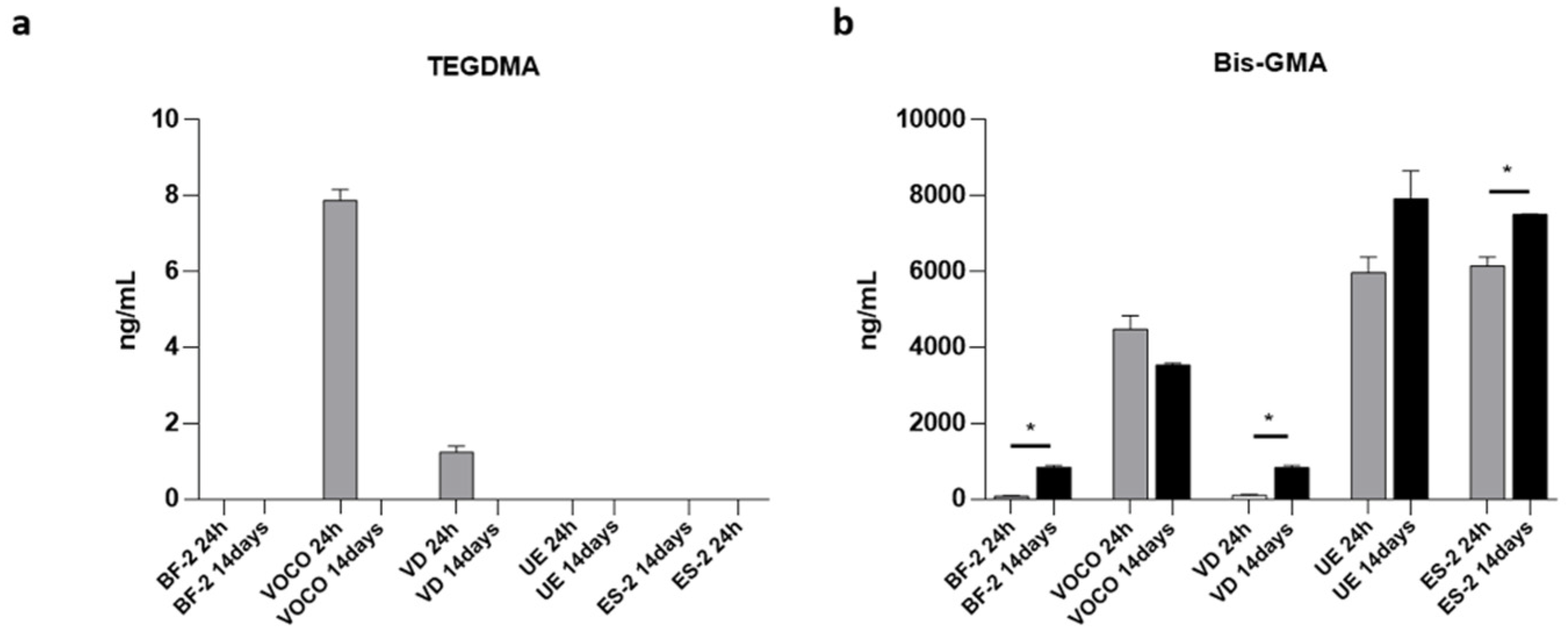
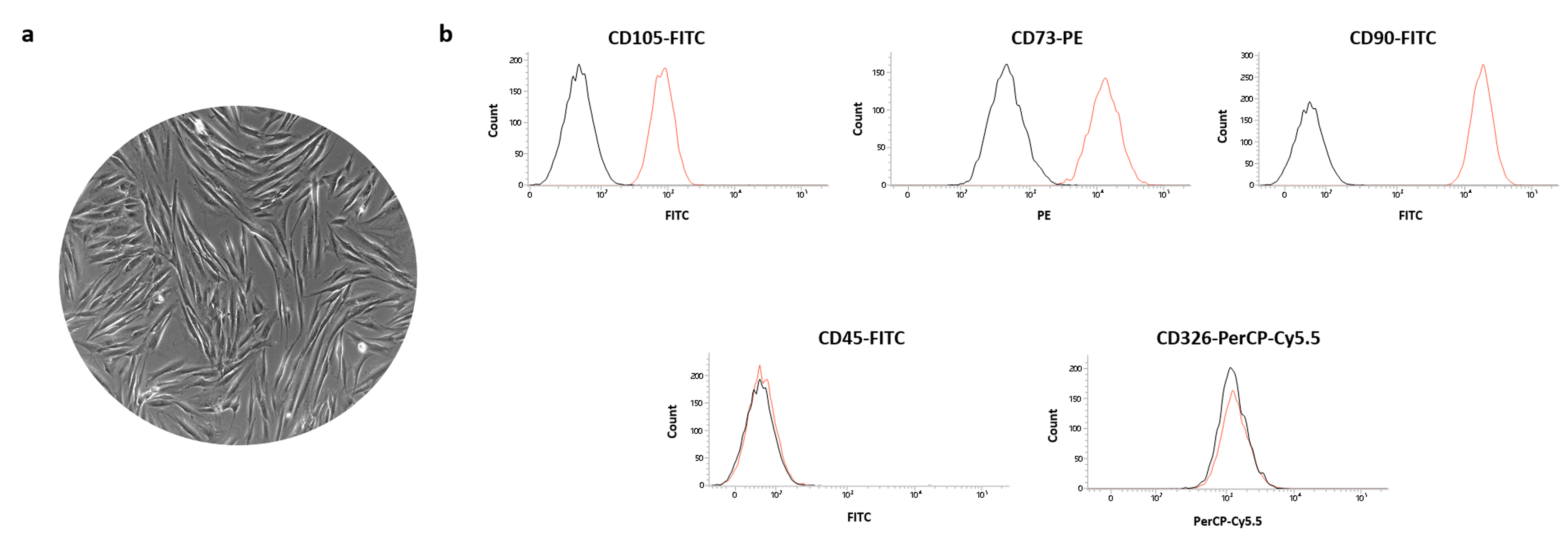
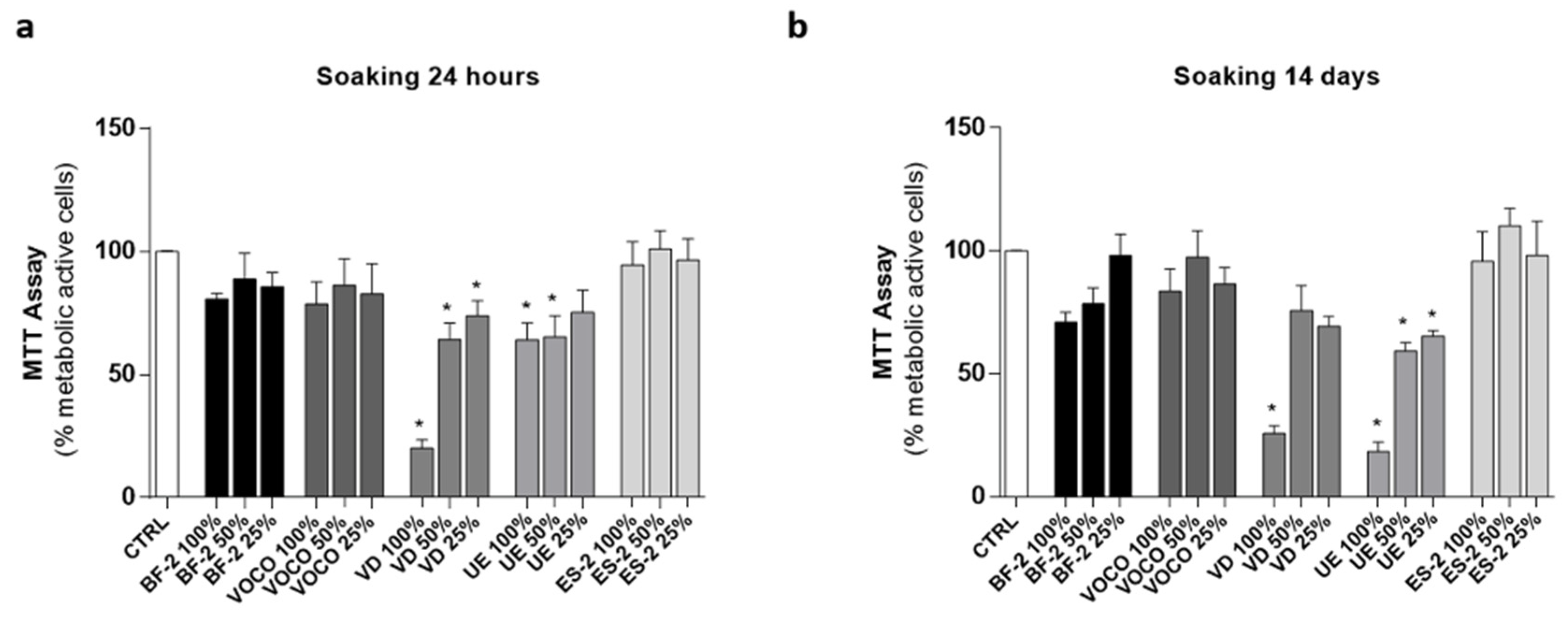
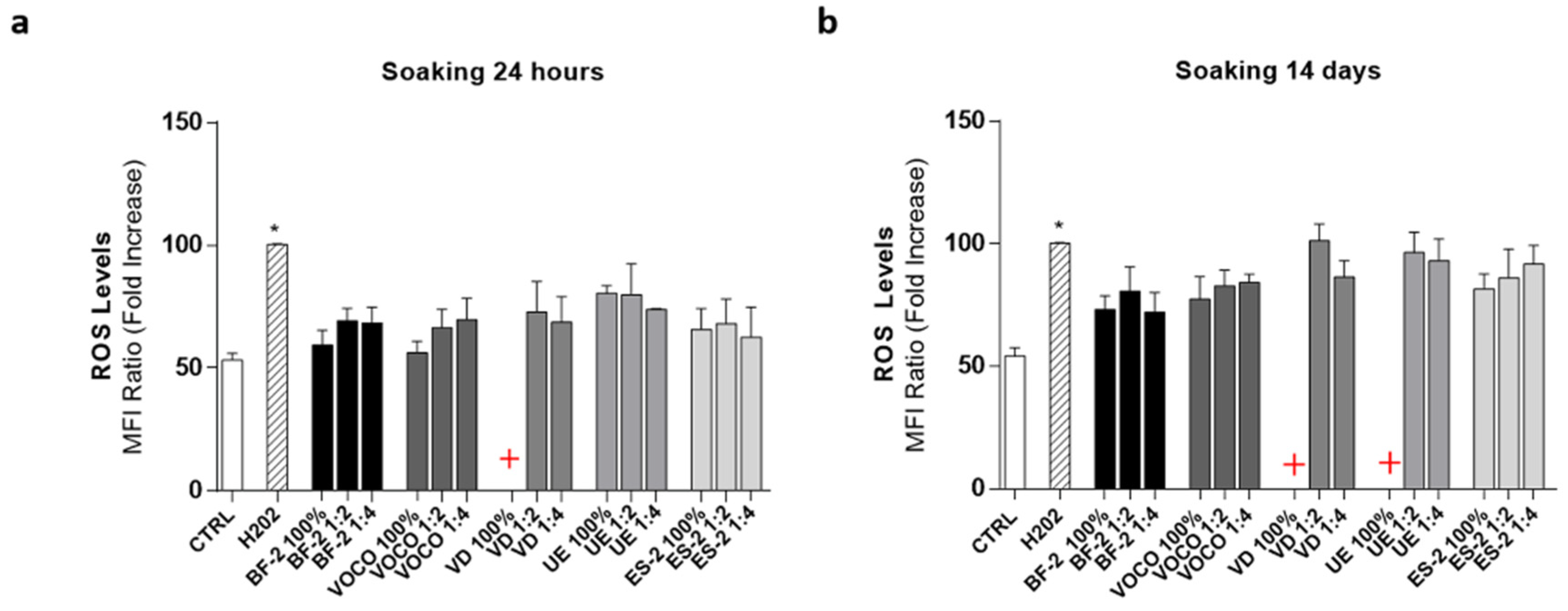
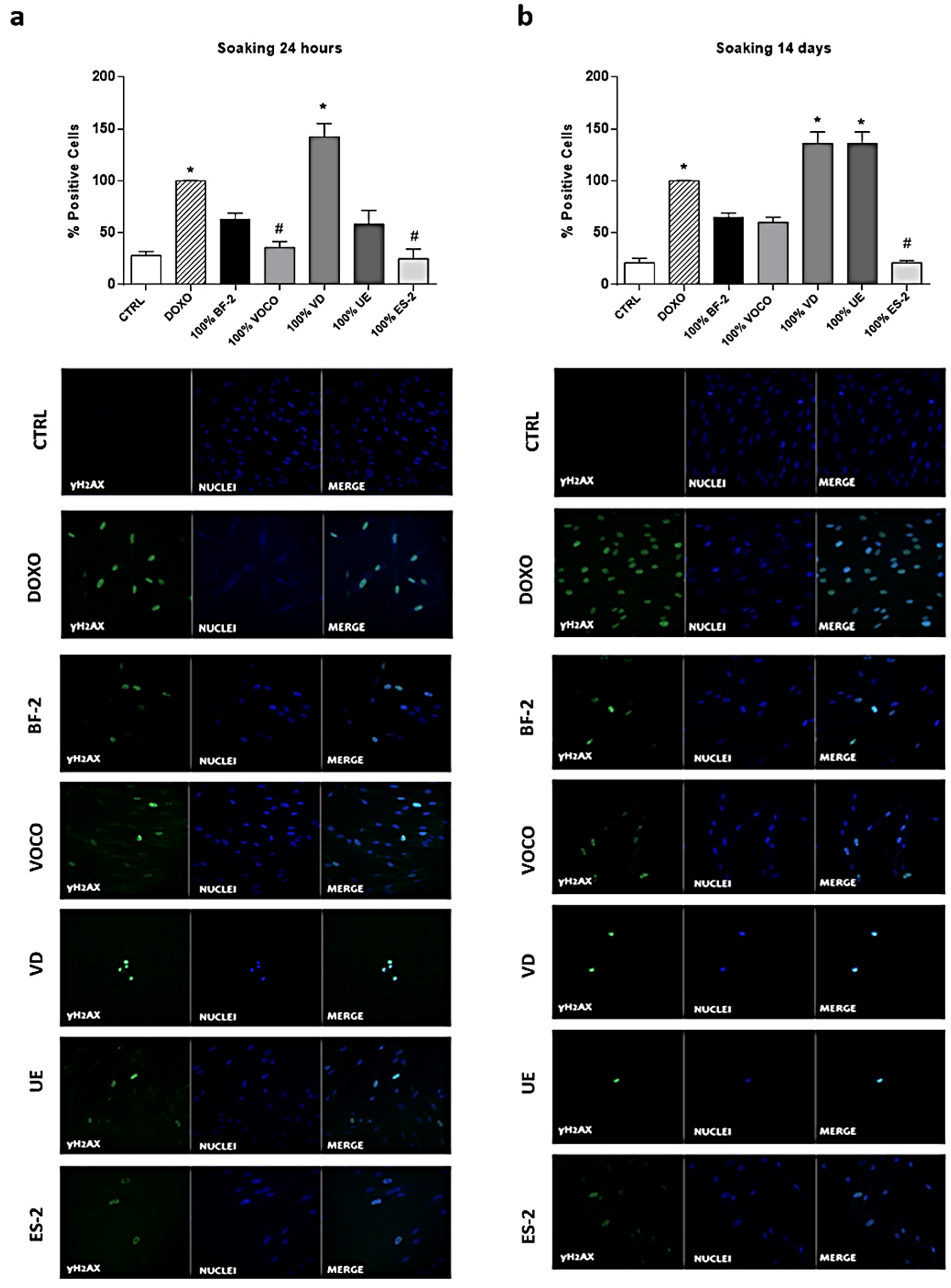
| Group | Name | Shade | Manufacturer | Batch | Composition | Category |
|---|---|---|---|---|---|---|
| BF-2 | Enamel BioFunction | BF2 | Micerium S.p.A. | 2019008149 | 74% wt fillers (5–50 nm silicon dioxide; 0,2–3 μm glass fillers) | Nanohybrid |
| (Avegno, Italy) | UDMA, Tricyclodecane dimethanol dimethacrylate | |||||
| VOCO | GrandioSO | A2 | Voco GmbH | 1847313 | 89 % wt fillers (1 μm glass ceramic fillers; 20–40 nm silicon dioxide fillers) | Nanohybrid |
| (Cuxhaven, Germany) | Bis-GMA, Bis-EMA, TEGDMA | |||||
| VD | Venus Diamond | A2 | Kulzer GmbH | K010070 | 80–82% wt fillers (5 nm–20 μm barium aluminum fluoride glass fillers) | Nanohybrid |
| (Hanau, Germany) | TCD-Urethaneacrylate, UDMA, TEGDMA | |||||
| UE | Enamel-plus HRi | Micerium S.p.A. | 80% fillers wt (0.1 µm glass fillers, 20 nm zirconium nanoxides) | Nanohybrid | ||
| (Avegno, GE, Italy) | UDMA, Bis-GMA, 1,4 Butanediol dimethacrylat (BDDMA) | |||||
| ES-2 | Clearfil Majesty ES-2 Classic | A2 | Kuraray | 7D008 | 78% fillers wt (0.37 μm–1.5 μm silanated barium glass fillers, pre-polymerized organic fillers) | Nanohybrid |
| (Chiyoda, Tokyo, Japan) | Bis-GMA, Hydrophobic aromatic dimethacrylate |
| Analyte | Parent (m/z) | Daughter (m/z) | Cone (V) | Collision Energy (eV) |
|---|---|---|---|---|
| TEGDMA | 287.2 | 113.1 | 50 | 8 |
| Bis-GMA | 513.2 | 143.1 | 50 | 15 |
Publisher’s Note: MDPI stays neutral with regard to jurisdictional claims in published maps and institutional affiliations. |
© 2021 by the authors. Licensee MDPI, Basel, Switzerland. This article is an open access article distributed under the terms and conditions of the Creative Commons Attribution (CC BY) license (https://creativecommons.org/licenses/by/4.0/).
Share and Cite
De Angelis, F.; Mandatori, D.; Schiavone, V.; Melito, F.P.; Valentinuzzi, S.; Vadini, M.; Di Tomo, P.; Vanini, L.; Pelusi, L.; Pipino, C.; et al. Cytotoxic and Genotoxic Effects of Composite Resins on Cultured Human Gingival Fibroblasts. Materials 2021, 14, 5225. https://doi.org/10.3390/ma14185225
De Angelis F, Mandatori D, Schiavone V, Melito FP, Valentinuzzi S, Vadini M, Di Tomo P, Vanini L, Pelusi L, Pipino C, et al. Cytotoxic and Genotoxic Effects of Composite Resins on Cultured Human Gingival Fibroblasts. Materials. 2021; 14(18):5225. https://doi.org/10.3390/ma14185225
Chicago/Turabian StyleDe Angelis, Francesco, Domitilla Mandatori, Valeria Schiavone, Francesco Paolo Melito, Silvia Valentinuzzi, Mirco Vadini, Pamela Di Tomo, Lorenzo Vanini, Letizia Pelusi, Caterina Pipino, and et al. 2021. "Cytotoxic and Genotoxic Effects of Composite Resins on Cultured Human Gingival Fibroblasts" Materials 14, no. 18: 5225. https://doi.org/10.3390/ma14185225
APA StyleDe Angelis, F., Mandatori, D., Schiavone, V., Melito, F. P., Valentinuzzi, S., Vadini, M., Di Tomo, P., Vanini, L., Pelusi, L., Pipino, C., Del Boccio, P., D’Arcangelo, C., & Pandolfi, A. (2021). Cytotoxic and Genotoxic Effects of Composite Resins on Cultured Human Gingival Fibroblasts. Materials, 14(18), 5225. https://doi.org/10.3390/ma14185225











